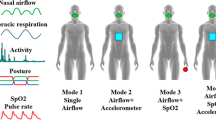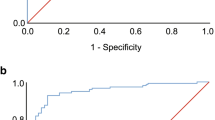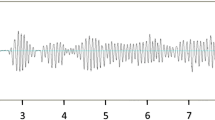Abstract
Purpose
The aim of the current pilot study is to compare the diagnostic accuracy of the NOX T3TM (T3) portable sleep monitor (PM) to that of simultaneously recorded in-lab polysomnogram (PSG).
Methods
A total of 40 participants were recruited following face-to-face evaluation at a sleep disorders clinic. Each participant wore both PSG and PM equipment simultaneously during their in-lab PSG. PSG records were manually scored using the American Academy of Sleep Medicine (AASM) criteria, and PM records were double-scored using the device’s autoscore algorithm as well as manual scoring.
Results
The final sample consisted of 32 participants (56 % male, 50 % black) with a mean ESS, BMI, and apnea–hypopnea index (AHI) of 10.4, 32.8, and 16.3, respectively. Three participants (7.5 %) were excluded for poor PM signal quality. Mean AHI derived from the T3’s autoscore algorithm was similar to that from manual scoring (19.6 ± 18.9 vs. 18.6 ± 19.1, respectively). Autoscore-derived T3 AHI and PSG-derived AHI were strongly related (r = .93). The T3 (autoscored AHI) demonstrated a high degree of sensitivity for the presence of obstructive sleep apnea syndrome (OSA; 100 %) and acceptable specificity for the exclusion of OSA using an AHI cutoff of ≥5 events/h (70 %). The unit (autoscored) had a high degree of both sensitivity (92 %) and specificity (85 %) when the presence of OSA was defined more conservatively (AHI > 15 events/h). For OSA defined as an AHI of ≥5, the T3 (autoscored) correctly identified 88 % of positive cases and 100 % of negative cases.
Conclusions
In this small, clinic-based sample, the T3 demonstrated very good measurement agreement compared to PSG and a high degree of sensitivity for detecting even mild OSA. False positives appeared to be due to respiratory effort-related arousals (RERAs) being autoscored as obstructive apneas and may be due to inherent discrepancy in flow measurement sensitivity between PSG and portable monitors.



Similar content being viewed by others
References
Young T, Palta M, Dempsey J, Peppard PE, Nieto FJ, Hla KM (2009) Burden of sleep apnea: rationale, design, and major findings of the Wisconsin Sleep Cohort study. WMJ 108(5):246–249
Young T, Peppard PE, Gottlieb DJ (2002) Epidemiology of obstructive sleep apnea: a population health perspective. Am J Respir Crit Care Med 165(9):1217–1239
United Healthcare (2012) Polysomnography and portable monitoring for evaluation of sleep related breathing disorders: medical policy. United Healthcare, Minnetonka
Aetna (2013) Clinical policy bulletin: obstructive sleep apnea in adults. Aetna, Hartford
Collop NA, Anderson WM, Boehlecke B, Claman D, Goldberg R, Gottlieb DJ, Hudgel D, Sateia M, Schwab R (2007) Clinical guidelines for the use of unattended portable monitors in the diagnosis of obstructive sleep apnea in adult patients. Portable Monitoring Task Force of the American Academy of Sleep Medicine. J Clin Sleep Med 3(7):737–747
Driver HS, Pereira EJ, Bjerring K, Toop F, Stewart SC, Munt PW, Fitzpatrick MF (2011) Validation of the MediByte(R) type 3 portable monitor compared with polysomnography for screening of obstructive sleep apnea. Can Respir J 18(3):137–143
Santos-Silva R, Sartori DE, Truksinas V, Truksinas E, Alonso FF, Tufik S, Bittencourt LR (2009) Validation of a portable monitoring system for the diagnosis of obstructive sleep apnea syndrome. Sleep 32(5):629–636
Flemons WW, Littner MR, Rowley JA, Gay P, Anderson WM, Hudgel DW, McEvoy RD, Loube DI (2003) Home diagnosis of sleep apnea: a systematic review of the literature. An evidence review cosponsored by the American Academy of Sleep Medicine, the American College of Chest Physicians, and the American Thoracic Society. Chest 124(4):1543–1579
Collop NA, Tracy SL, Kapur V, Mehra R, Kuhlmann D, Fleishman SA, Ojile JM (2011) Obstructive sleep apnea devices for out-of-center (OOC) testing: technology evaluation. J Clin Sleep Med 7(5):531–548
Berry RB, Budhiraja R, Gottlieb DJ, Gozal D, Iber C, Kapur VK, Marcus CL, Mehra R, Parthasarathy S, Quan SF, Redline S, Strohl KP, Davidson Ward SL, Tangredi MM (2012) Rules for scoring respiratory events in sleep: update of the 2007 AASM Manual for the Scoring of Sleep and Associated Events. Deliberations of the Sleep Apnea Definitions Task Force of the American Academy of Sleep Medicine. J Clin Sleep Med 8(5):597–619
Epstein LJ, Kristo D, Strollo PJ Jr, Friedman N, Malhotra A, Patil SP, Ramar K, Rogers R, Schwab RJ, Weaver EM, Weinstein MD (2009) Clinical guideline for the evaluation, management and long-term care of obstructive sleep apnea in adults. J Clin Sleep Med 5(3):263–276
Kushida CA, Littner MR, Morgenthaler T, Alessi CA, Bailey D, Coleman J Jr, Friedman L, Hirshkowitz M, Kapen S, Kramer M, Lee-Chiong T, Loube DL, Owens J, Pancer JP, Wise M (2005) Practice parameters for the indications for polysomnography and related procedures: an update for 2005. Sleep 28(4):499–521
Iber C, Ancoli-Israel S, Chesson AL, Quan SF (2007) The AASM manual for the scoring of sleep and associated events: rules, terminology and technical specifications. The American Academy of Sleep Medicine, Westchester
Yin M, Miyazaki S, Ishikawa K (2006) Evaluation of type 3 portable monitoring in unattended home setting for suspected sleep apnea: factors that may affect its accuracy. Otolaryngol Head Neck Surg 134(2):204–209
Acknowledgments
A special thank you to our dedicated team of sleep technologists: Dorothy Covey, Emily Evans, Oyetunde Oyeduken, David Aghajanian, and Jess Sevidel. Also, thank you to NOX Medical for supplying all research materials.
Conflict of interest
The authors have no conflicts of interest or off-label investigational use to disclose.
Author information
Authors and Affiliations
Corresponding author
Additional information
Conference Presentation: These data were presented at the annual Associated Professional Sleep Societies (APSS) conference.
Rights and permissions
About this article
Cite this article
Cairns, A., Wickwire, E., Schaefer, E. et al. A pilot validation study for the NOX T3TM portable monitor for the detection of OSA. Sleep Breath 18, 609–614 (2014). https://doi.org/10.1007/s11325-013-0924-2
Received:
Revised:
Accepted:
Published:
Issue Date:
DOI: https://doi.org/10.1007/s11325-013-0924-2




